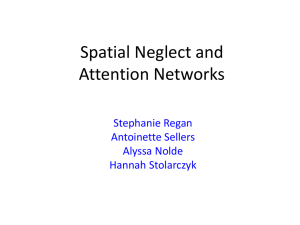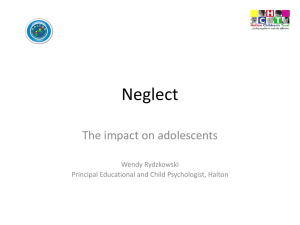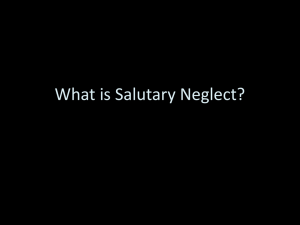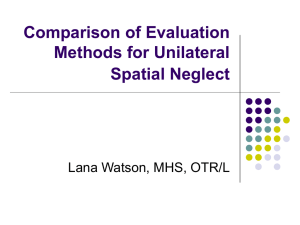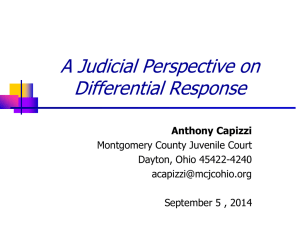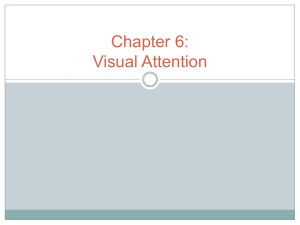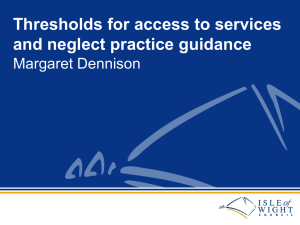The Effects of Virtual Reality on Visual Neglect
advertisement
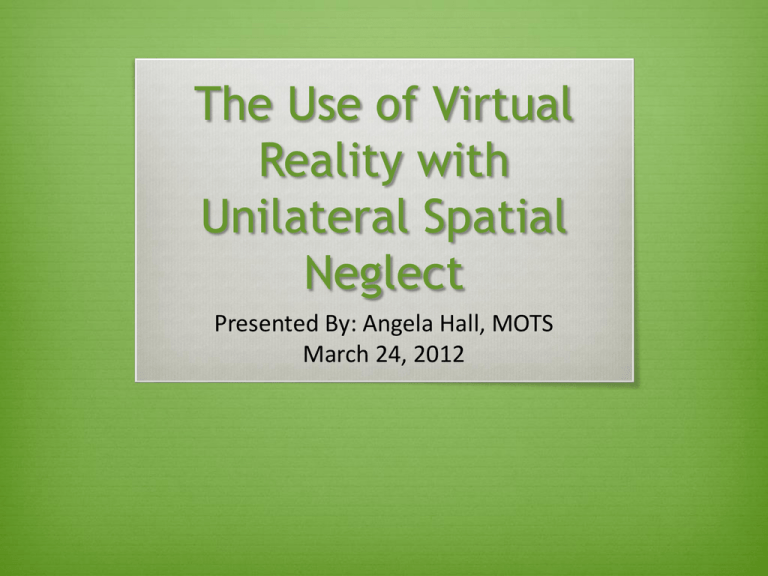
The Use of Virtual Reality with Unilateral Spatial Neglect Presented By: Angela Hall, MOTS March 24, 2012 Objectives Background Information on CVA, Unilateral Spatial Neglect, and Virtual Reality Objective of the Systematic Review Search Strategies Summary of Study Procedures Methodology Results Implications for OT practice and future research Background Cerebrovascular Accident Hemorrhagic photo: www.nhlbi.nih.gov Cerebrovascular Accident Ischemic photo: www.nhlbi.nih.gov CVA Complications Hemiplegia Apraxia Impaired Impulsivity Judgment Impaired Spatial Relations Unilateral Spatial Neglect Impaired Balance & Coordination Poor Attention Span Weakness Aphasia National Stroke Association Unilateral Spatial Neglect Weiss, Naveh, & Katz, 2003 USN and Function Impaired ability to perform self-care activities Poor mobility Difficulty feeding oneself Impaired reading comprehension Impaired safety Buxbaum et al, 2008; Weiss et al, 2003 Current Assessment Behavioral Inattention Test Line bisection Cancellation Drawing Reading/Writing Buxbaum et al, 2008; Pierce & Buxbaum, 2002 Current Treatment photos: kesslerfoundation.org, Harding & Riddoch, 2008 Buxbaum et al, 2008; Pierce & Buxbaum, 2002 Virtual Reality nmr.mgh.harvard.edu Weiss et al, 2003 Benefits of VR Experience real-life situations in safe environment Simple to change environment & grade activity Provides immediate feedback Repeated learning trials Produces computer generated output May provide information on head and eye movements Weiss et al, 2003 Objective The objective of this review is to examine the extent to which the research literature supports the use of virtual reality as an effective assessment tool and treatment technique for patients experiencing USN following a CVA Search Terms stroke virtual technologies cerebrovascular left visual neglect accident visual neglect unilateral spatial neglect virtual reality unilateral neglect hemineglect Summary of Study Procedures Study Sizes Groups Eight studies included a patient group with 2-12 participants and a control group with 3-21 participants Two studies used only one group Four participants Eight participants Participants Gender Four studies included more men One study included more women Three studies included equal amounts of men and women Two studies did not specify participant gender Participants Patient Groups Eight of ten studies included participants ranging in age from 34-77 Eight of ten studies included participants with a right hemispheric lesion Eight of ten studies required participants to exhibit clinical visual neglect All ten studies required participants to understand directions and have functional use of at least one limb Exclusion criteria: Substance abuse and prior history of neurological or visual impairment Participants Control Groups Included participants ranging from 34-77 Seven studies used groups of neurologically healthy individuals One study used patients with right hemispheric lesions Exclusion criteria: Substance abuse and prior history of neurological or visual impairment Interventions & Outcomes VR as an Assessment Study One The star cancellation portion of the Behavioral Inattention Test (BIT) and baking tray test Cancellation test in the VR environment Study Two Completed the line and star cancellation subtests of the BIT Same tests using two lenses on a head-mounted display Study Three BIT 3D neglect test consisting of a city environment Broeren et al., 2007; Tanaka et al., 2005; Jannink et al., 2009; VR as an Assessment (2) Study Four Used a “VREye” system to differentiate between eye tracking patterns of the control and patient groups by asking participants to identify 10 objects and the time on a clock Study Five Participants navigated wheelchair along a virtual path with a variety of conditions Moss-Magee Wheelchair Navigation test, several subtests of the BIT, and the Bell test Gupta et al., 2000; Buxbaum et al., 2008 VR as an Intervention Study One Practiced street crossing in a virtual environment twelve times over a 4-week period. Frequency, order and direction of subjects’ search Number of trials and length of time it took to complete each level Highest level successfully completed at the end of training. Ability to cross a real street safely Study Two Patients trained on virtual street crossing, Deviation angle Reaction time Visual and auditory cues required Failure rate of missions. Weiss et al., 2003; Kim et al., 2007 VR as an Intervention (2) Study Three Compared group receiving VR street crossing to a group receiving visual scanning training. Outcome measures: Star cancellation from the BIT, Mesulam Symbol Cancellation test, ADL checklist, virtual reality street crossing test, and a real street crossing test. Study Four Participants received six weeks of VR training consisting of “Birds and Balls” and “Soccer” games. Outcomes measured by comparing pre-post test scores on the Bell’s test and BIT. Katz et al, 2005; Smith; 2007; Ansuini et al, 2006) VR as an Intervention (3) Study Five Participants reached for real objects located at 1 of the 3 locations while viewing the real-time virtual representation of their hand. Outcome results were measured based on the percentages of trials in which the object was successfully detected. Common Limitations Lack of randomization No blinding of test administrator Short duration of treatment None of the patient groups had more than 12 subjects Only one study had significant number of participants (n=50; Kim et al., 2007) Unequal groups Failure to mention psychometric properties of assessments Failure to use all subsections of a test Results Assessment Results Study One (Broeren et al., 2007) Showed that VR testing yielded more sensitive results 6 of 8 patients demonstrated a difference in search patterns Patients had more hand deviation when moving from targets Study Two (Tanaka et al., 2005) Significant difference between conventional neglect assessments and virtual reality assessments on the left side (p<0.05). Assessment Results (2) Study Three (Buxbaum et al., 2008) Patients scored below the control group in four conditions. Significant differences within the patient group with complexity of object array (p<0.01) and side of object presentation (p<0.05) Study Four (Jannink et al., 2009) Significant differences exist between groups in total time spent at the test (p=0.049) and mean response time in left field of view (p=0.037). No significant differences were found at level 3. Assessment Results (3) Study Five (Gupta et al., 2000) Control patients were able to identify and count all objects and view the entire display. Patient with left neglect identified only 3 of 10 objects and reported the wrong time. Patient with right neglect was only able to identify one of the objects and reported an incorrect time. Intervention Results Study One (Kim et al, 2007) Significant differences (p<0.05) found in deviation angle, reaction time, visual cues, auditory cues, and failure rate of mission. Study Two (Weiss et al, 2003) Patient group took longer to complete street crossing levels and had more total accidents. Control group had more accidents in level 3, but the patient group had more accidents in level 5. Intervention Results (2) Study Three (Katz et al, 2005) Improvements (p<0.05) for the group receiving VR training and the group receiving computerized scanning on and ADL checklist. The VR group made significant improvements in looking left (p<0.05) and number of accidents (p<0.035) in virtual street crossing. No significant difference in real street crossing Intervention Results (3) Study Four (Smith, 2007) Found no significant differences in the scores of these patients after 6 weeks of intervention. Qualitative remarks suggest that the clients found the interventions helpful. Study Five (Ansuini et al., 2006) Patients with a fronto-parietal lesion demonstrated significant improvements in response to left targets (p<0.01) and on the sensory task (p< 0.01) while patients with a temporo-parietal lesion did not show improvements. Discussion Virtual reality may be an effective assessment tool that can provide more information and more sensitive results compared to conventional neglect assessments. Studies have compromised validity Results showed differences in search patterns in two studies, but the authors did not address whether this may be due to visual scanning deficits (Broeren et al., 2007; Gupta et al., 2000). Discussion (2) Many of the studies showed statistical differences between the patient groups and control groups Expected result because control groups were primarily composed of healthy individuals. Two studies presented evidence suggesting that VR may be more sensitive at detecting mild neglect (Broeren et al., 2007; Jannink et al., 2009). Some patients who were considered “clinically recovered” by conventional assessments demonstrated at least mild neglect on VR assessments especially with complex environments Discussion (3) In one study, patients improved performance in the VR environment, but this did not translate to a reallife setting. May indicate that VR training has limited carry over for functional improvements. The vast array of VR technology utilized limits generalizability. Evidence demonstrates the emerging potential for virtual reality in the assessment and treatment of visual neglect following a CVA. Conclusions Implications for OT Practice VR can help patients and families become more aware of the deficits and safety challenges May help improve space deficits and maximize compensation of the contralateral visual side to help patients maximize performance in ADLs. Offers OTs the opportunity to provide the patient with real-time performance feedback and detailed recordings of kinematics of the hand allowing for more in-depth tracking of the progress Implications for OT Practice (2) Potential to detect and measure USN in sub-acute and chronic stages of stroke recovery. Help clients become aware of what they are missing in the real-world and develop strategies to compensate for the neglect. VR test was also sensitive to mild neglect that is often difficult to detect with conventional neglect assessments. Implications for Future Research Improved studies using larger sample sizes, different virtual environments, and patients with various motor and cognitive impairments to generalize specific training skills. Focus on increasing the array of complexity of objects presented to the clients. Test the effect of dynamic objects versus static objects on subjects’ eye movements and to determine if this technique can be used to train subjects to visualize information on the neglected side. Questions? References Ansuini, C., Pierno, A., Lusher, D., & Castiello, U. (2006). Virtual reality applications for the remapping of space in neglect patients. Restorative Neurology and Neuroscience, 24, 431—441. Broeren, J. J., Samuelsson, H. H., Stibrant-Sunnerhagen, K. K., Blomstrand, C. C., & Rydmark, M. M. (2007). Neglect assessment as an application of virtual reality. Acta Neurologica Scandinavica, 116(3), 157-163. Buxbaum, L., Ferraro, M., Veramonti, T., Farne, A., Whyte, J., Ladavas, E., Frassinetti, F., Coslett, H. (2004). Hemispatial neglect: Subtypes, neuroanatomy, and disability. Neurology, 62(5), 749-756. Buxbaum, L. J., Palermo, M., Mastrogiovanni, D., Read, M., Rosenberg-Pitonyak, E., Rizzo, A. A., & Coslett, H. (2008). Assessment of spatial attention and neglect with a virtual wheelchair navigation task. Journal of Clinical & Experimental Neuropsychology, 30(6), 650-660. Centers for Disease Control and Prevention. (2011). Stroke. Retrieved from http://www.cdc.gov/stroke/ References Gupta, V., Knott, B. A., Kodgi, S., & Lathan, C. E. (2000). Using the "vreye" system for the assessment of unilateral visual neglect: Two case reports. Presence: Teleoperators & Virtual Environments, 9(3), 268-286. Jannink, M., Aznar, M., de Kort, A., van de Vis, W., Veltink, P., van der Kooij, H. (2009) Assessment of visuospatial neglect in stroke patients using virtual reality: a pilot study. International Journal of Rehabilitation Research, 32(4), 280-286. Katz, N. N., Ring, H. H., Naveh, Y. Y., Kizony, R. R., Feintuch, U. U., & Weiss, P. L. (2005). Interactive virtual environment training for safe street crossing of right hemisphere stroke patients with unilateral spatial neglect. Disability & Rehabilitation, 27(20), 1235-1244. doi:10.1080/09638280500076079 Kim, J., Kim, K., Kim, D.Y., Chang, W.H., Park, C., Ohn, S.H., Han, K., Ku, J., Nam, S.W., Kim, I.Y., Kim, S.I. (2007). Virtual environment training system for rehabilitation of stroke patients with unilateral neglect: Crossing the virtual street. CyberPsychology & Behavior, 10(1), 7-15. doi:10.1089/cpb.2006.9998 Smith, J., Hervert, D., Reid, D. (2007). Exploring the effects of virtual reality on unilateral neglect caused by a stroke: Four case studies. Technology and Disability 19, 29-40 National Stroke Association. (2011). Stroke survivors: Effects of stroke. Retrieved from http://www.stroke.org/site/PageServer?pagename=EFFECT. References Pierce, S., & Buxbaum, L. (2002). Treatments of unilateral neglect: A review. Archives of Physical Medicine and Rehabilitation, 83(2), 256-268. Tanaka, T., Sugihara, S., Nara, N., Ino, S., Ifukube, T. (2005). A preliminary study of clinical assessment of left unilateral spatial neglect using a head mounted display system (hmd) in rehabilitation engineering technology. Journal of NeuroEndgineering and Rehabilitation, 2(1), 31-40. Taylor, D. (2003) Measuring mild visual neglect: Do complex visual tests activate rightward attentional bias? New Zealand Journal of Physiotherapy, 31(2), 67-72. Weiss, P. L., Naveh, Y., & Katz, N. (2003). Design and testing of a virtual environment to train stroke patients with unilateral spatial neglect to cross a street safely. Occupational Therapy International, 10(1), 39.
